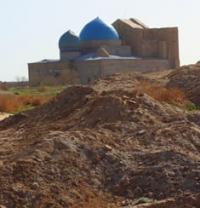Вы здесь
Historical background Kazakhstan.

Republic of Kazakhstan.
“I've known rivers:
I've known rivers ancient as the world and older than the flow of human blood in human veins. My soul has grown deep like the rivers”
Langston Hughes.
Archaeological of Kazakhstan.
A new state - the Republic of Kazakhstan - appeared on the world political map in 1991 Kazakh history and culture span thousands of years. Questions about the native people, i.e. the Kazakhs' origin, formation and background of their government, culture and cultural tradition's development and relations with other civilisations is one of the central interests.
If we refer to written sources, it can state, that the Kazakhs' government was developed to 1470. This was when Janibek and Kerei, the Kazakh sultans, became leaders of many tribes, united into the "Kazakh" people, within Kazakhstan, in its South-Eastern regions (i.e. Zhetysu (Semirechye) and in the Chu River valley).
The Kazakh khanate existed up to 1716, when Taukekhan, the last khan of all the united Kazakhs, died and the power was transferred to numerous steppe khans, each of which headed separate Kazakh groups and territories. The "Kazakh" ethnic name, which gave the state it's name, is a Turkic word.
According to the majority of researchers' opinion, it means "a free person". The Kazakhs were the freedom-loving nomads and farmers, who possessed numerous healthy herds of animals, luxuriant pastures and fertile lands in the foothills and river valleys.
However, speaking about the Kazakhs and the first Kazakh State, i.e. the Kazakh Khanate, it is necessary to know, that these people's origin, as well as background of their state and culture go back many centuries. Archaeological discoveries and monuments, surviving till today, verify this history.
The tribes of, the so called, Androne and Begazy-Dandybai culture already lived on the territory of Kazakhstan by the Bronze Age, four thousands years ago. They were engaged in pastoralism and cattle breeding, and were excellent warriors, mastering the military chariot.
The notable barrows, scattered throughout the Kazakh steppe, differ markedly in sizes of embankments and burial-vaults. The Begazy and Dandybai burial sites are the most important in the Sary-Arka and Tegisken steppes in the Pre-Aral (area surrounding the Aral sea).
Warriors' weapons, axes, bronze daggers and spears were put into the graves with them. Horses, harnessed into chariots, were sometimes buried, also. People of that epoch were not only excellent warriors, herders and farmers, but also, excellent metallurgists.
They made bronze axes, knives, scissors, daggers and jewellery. It was they, who started to develop copper deposits, which are now still in use. They are the Zhezkazgan and Sayak copper open-cut mines. Peopled lived in large settlements, in dugouts and free standing houses.
But there were also ancient towns, surrounded by walls and ditches and built with dwellings according to a strict plan. Warriors and craftsmen, priests and farmers lived in these towns. The Saki came in their turn. As the ancient Persians called that new nation; the Chinese called them "the Se"; and the Greeks, "the Scythians".
They were nomadic, semi-nomadic and agricultural. But first of all, they were excellent horsemen. The Saki were the first in the world to learn shooting from a bow at a full gallop. A Scythian or Saki rider served as the inspiration for the mythical Centaur.
The Saki developed their first state on the territory of Kazakhstan in the IVth to IIIrd centuries В. С., the core of which was located on the Zhetysu territory in south-eastern Kazakhstan. The Saki's leaders also carried out the Supreme Priests role. The Saki had their own writing, mythology and outstanding world-class art, named in literature, as "Animal Style Art".
Subjects are hunting and grazing animals, and the struggle between them. Masterpieces of that period, made from gold and bronze, enliven exhibits in the worlds museums. The language situation was complex. It is considered, that during the 1st millennium В. С. the Kazakhstan population consisted, mainly, of Indo-European and Indo-Iranian language speakers.
But currently, the opinion more and more verified is, that among the Bronze Age tribes there were tribes speaking in the Proto-Turkic languages, especially, among the Saki and Usuni tribes. The West-Turkic, Turgesh and Karluk kaganates, Oguzes, Karakhanids, Kimaks and Kypchaks states had existed on the territory of Kazakhstan, since the VIth century up to the XIIIth century, influenced each other up to the Mongolian Invasion.
The Uluses of the Mongolian Empire were formed after the Mongolian Invasion at the beginning of the XIIIth century, i.e. the Dzhuchis and Dzhagatais, which gave birth to Ak-Orda, and later to the Kazakh Khanate. All these states had a mixed economy.
The cattle herding tribes neighboured the farming tribes, steppe and town complemented each other. Taraz, Otrar, Ispidzhab and Talkhiz towns were located on the Great Silk Road which connected the West and the East from ancient times to the Middle Ages - Japan, Korea and China with central Asia Iran, Seldzhuks State, Russia and Byzantium.
Different goods were delivered through that Road: silk, linen, precious stones, silver, medicine, spices; horses, falcons elephants, cheetahs, rhinoceroses and ostriches for sale and as rare gifts; and the slave trade was resourced.
Dance, art, раinting, architecture and music were shared through the Great Silk Road. Religion was also spread through it: Manicheaism, Buddhism, Christianity and Islam; which became the prevailing religion at the beginning of the VIIIth century and then the Kazakhs' religion.
The Khodzhy Akhmed Yassaui's Complex, a place of piligrimge for the Kazakhs and all Turkic peoples was set up in Turkestan, on the Syr-Darya River bank at the turn of the XIVth - to the XVth century. 'With the legacy of the ancient Kazakh's relationship to the land, the period of its organized state, economic -md cultural origins; Kazakhstan strives to occupy a respected place in the world community.
Authority:
"Zhetysu is the Land of tourism”. A Tourist Guide-book. Almaty. 2012. 68 p. and the material for this page is taken from the printed edition.
Photos by:
Alexander Petrov.







